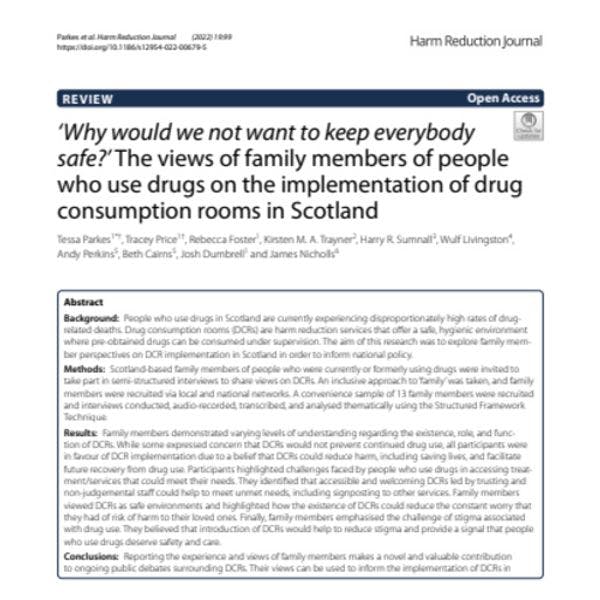« Pourquoi ne voudrions-nous pas que tout le monde soit en sécurité ? » Le point de vue de membres de familles de personnes usagères de drogues sur la mise en œuvre de lieux de consommation à moindres risques en Écosse
Parkes, Price et al. constatent que les membres des familles soutiennent les lieux de consommation à moindres risques comme moyens de limiter les dommages, la stigmatisation et les obstacles à l’accès aux services. Pour en savoir plus, en anglais, veuillez lire les informations ci-dessous.
By Tessa Parkes, Tracey Price, Rebecca Foster, Kirsten M. A. Trayner, Harry R. Sumnall, Wulf Livingston, Andy Perkins, Beth Cairns, Josh Dumbrell & James Nicholls
Abstract
Background
People who use drugs in Scotland are currently experiencing disproportionately high rates of drug-related deaths. Drug consumption rooms (DCRs) are harm reduction services that offer a safe, hygienic environment where pre-obtained drugs can be consumed under supervision. The aim of this research was to explore family member perspectives on DCR implementation in Scotland in order to inform national policy.
Methods
Scotland-based family members of people who were currently or formerly using drugs were invited to take part in semi-structured interviews to share views on DCRs. An inclusive approach to ‘family’ was taken, and family members were recruited via local and national networks. A convenience sample of 13 family members were recruited and interviews conducted, audio-recorded, transcribed, and analysed thematically using the Structured Framework Technique.
Results
Family members demonstrated varying levels of understanding regarding the existence, role, and function of DCRs. While some expressed concern that DCRs would not prevent continued drug use, all participants were in favour of DCR implementation due to a belief that DCRs could reduce harm, including saving lives, and facilitate future recovery from drug use. Participants highlighted challenges faced by people who use drugs in accessing treatment/services that could meet their needs. They identified that accessible and welcoming DCRs led by trusting and non-judgemental staff could help to meet unmet needs, including signposting to other services. Family members viewed DCRs as safe environments and highlighted how the existence of DCRs could reduce the constant worry that they had of risk of harm to their loved ones. Finally, family members emphasised the challenge of stigma associated with drug use. They believed that introduction of DCRs would help to reduce stigma and provide a signal that people who use drugs deserve safety and care.
Conclusions
Reporting the experience and views of family members makes a novel and valuable contribution to ongoing public debates surrounding DCRs. Their views can be used to inform the implementation of DCRs in Scotland but also relate well to the development of wider responses to drug-related harm and reduction of stigma experienced by people who use drugs in Scotland and beyond.
